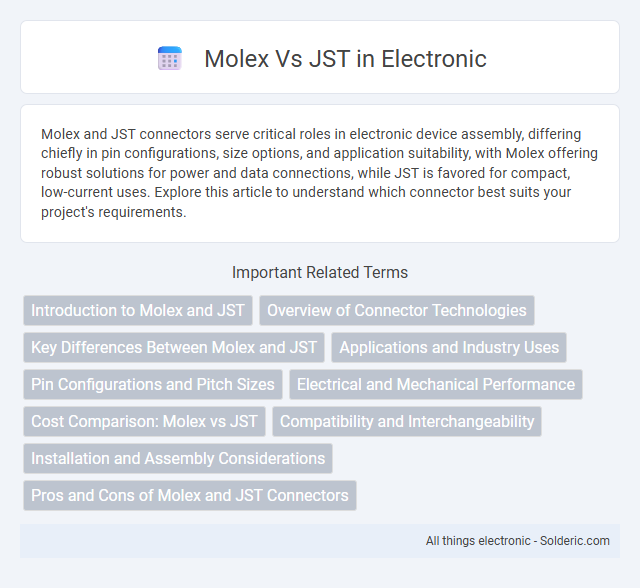Molex and JST connectors serve critical roles in electronic device assembly, differing chiefly in pin configurations, size options, and application suitability, with Molex offering robust solutions for power and data connections, while JST is favored for compact, low-current uses. Explore this article to understand which connector best suits your project's requirements.
Comparison Table
| Feature | Molex | JST |
|---|---|---|
| Company Origin | USA | Japan |
| Connector Types | Wire-to-wire, wire-to-board, board-to-board | Wire-to-wire, wire-to-board, board-to-board |
| Application | Automotive, industrial, consumer electronics, telecommunications | Consumer electronics, automotive, industrial, medical devices |
| Pin Pitch Range | 1.25mm to 5.08mm+ | 0.8mm to 5.0mm+ |
| Durability (Mating Cycles) | Up to 30,000 cycles (depends on series) | Typically 30 to 500 cycles |
| Current Rating | Up to 13A (varies by series) | Up to 3A (typical for smaller pitch connectors) |
| Market Presence | Global, strong in North America | Global, strong in Asia |
| Price Range | Mid to high range | Low to mid range |
| Special Features | High power solutions, ruggedized connectors, wide industrial support | Compact designs, precision manufacturing, high-density connectors |
Introduction to Molex and JST
Molex and JST are prominent manufacturers specializing in electronic connectors widely used in various industries. Molex offers a broad portfolio including power, signal, and data connectors known for durability and innovative designs. JST is recognized for its compact, reliable connectors commonly utilized in consumer electronics and automotive applications.
Overview of Connector Technologies
Molex and JST are leading manufacturers specializing in precision connector technologies widely used across electronics, automotive, and industrial applications. Molex connectors are renowned for their robust design and versatility, supporting power and signal transmission in complex systems, while JST connectors emphasize compact size and reliability in limited-space electronic devices. Understanding your specific application requirements will help determine whether Molex's broad range or JST's miniature connectors best suit your connectivity needs.
Key Differences Between Molex and JST
Molex connectors are known for their robust design and higher current handling capabilities, making them ideal for power-intensive applications, whereas JST connectors excel in compactness and are commonly used in low-current electronics such as hobbyist projects and small devices. The pin pitch of Molex connectors typically ranges from 2.54mm to 3.96mm, offering more spacing for durability, while JST connectors feature smaller pitches, often around 2.0mm or less, enabling dense circuit board layouts. Your choice depends on the specific electrical requirements, space constraints, and reliability standards needed for your electronics project.
Applications and Industry Uses
Molex connectors are extensively used in automotive, medical devices, and telecommunications due to their durability and high current capabilities, making them suitable for complex, high-reliability systems. JST connectors, favored in consumer electronics, RC hobby models, and small-scale battery connections, offer compact sizes and reliable performance in low-voltage applications. Both brands serve critical roles in electronics manufacturing, with Molex excelling in high-power environments and JST dominating compact, space-constrained designs.
Pin Configurations and Pitch Sizes
Molex connectors typically feature a wider range of pin configurations, including options from 2 to 24 pins, with pitch sizes commonly at 2.54mm, 3.96mm, and 5.08mm, catering to high-current and power applications. JST connectors offer more compact pitch sizes like 1.0mm, 1.25mm, and 2.0mm, making them ideal for space-constrained electronics and low-current signals. The choice between Molex and JST often depends on whether the application requires higher pin density with smaller pitch or more robust power connections with larger pitch sizes.
Electrical and Mechanical Performance
Molex and JST connectors both offer reliable electrical performance with low contact resistance, ensuring efficient current flow in various electronic applications. Molex connectors typically provide higher current ratings and durability, making them suitable for demanding environments requiring strong mechanical retention and vibration resistance. Your choice between Molex and JST should consider the specific voltage, current requirements, and mechanical stresses involved in your project to optimize connection reliability and longevity.
Cost Comparison: Molex vs JST
Molex connectors typically present a higher initial cost compared to JST due to their advanced design features and broader product range catering to industrial applications. JST connectors offer a more cost-effective solution, especially for mass production in consumer electronics, benefiting from simpler manufacturing processes and widespread availability. Evaluating total cost of ownership requires considering factors like durability, performance requirements, and potential maintenance expenses beyond the upfront price difference.
Compatibility and Interchangeability
Molex and JST connectors differ significantly in compatibility and interchangeability due to their unique pin configurations, pitch sizes, and locking mechanisms. Molex connectors typically feature larger pitches and a broader range of power applications, while JST connectors are favored for compact, low-power electronics with smaller pitches. Ensuring compatibility requires matching connector series and specifications precisely, as substituting one brand for the other without verification can lead to connection failures or damage to Your devices.
Installation and Assembly Considerations
Molex connectors generally offer straightforward installation with options for crimp, solder, and press-fit terminals, making them suitable for both automated and manual assembly processes. JST connectors are known for their compact design, which requires precise alignment during installation but allows for high-density configurations in tight spaces. Both brands provide reliable locking mechanisms, yet Molex connectors tend to be favored in applications demanding easier handling and quicker assembly times.
Pros and Cons of Molex and JST Connectors
Molex connectors offer robust durability and a wide range of pin configurations suited for high-current applications, but they tend to be larger and more expensive compared to JST connectors. JST connectors are compact, cost-effective, and ideal for low-current, space-constrained electronic devices, though they may lack the mechanical strength and versatility found in Molex connectors. Your choice depends on balancing size, cost, current requirements, and durability for optimal connector performance.
Molex vs JST Infographic

 solderic.com
solderic.com